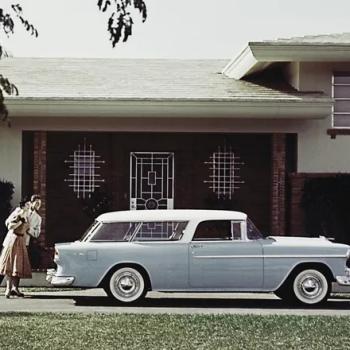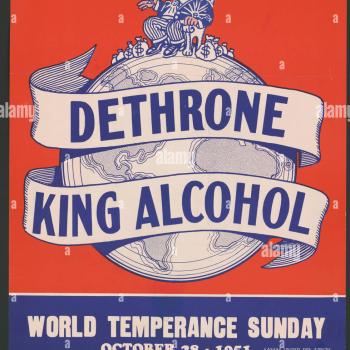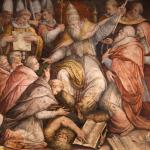I’m pleased to welcome Chuck Redfern to the Anxious Bench. Charles Redfern is a minister, writer, and activist, with an MDiv from Gordon Conwell Theological Seminary and an ordination from the American Baptist Churches, USA. He’s served several New England churches and now lives in Connecticut with his wife of 31 years and next door to his son, daughter-in-law, grandson, and their golden retriever.
–David
***
It’s time for evangelical myth busting.
I say that as the not-so-secret secret unravels: White American Evangelical Christianity has plunged into a theological, spiritual, and moral abyss. Many claiming the evangelical label laud an obviously decadent president while jettisoning the movement’s time-honored convictions: Lifeway Research found that majorities believe the Holy Spirit is an impersonal force, that Jesus was a created being, and that family worship is an acceptable swap for regular church attendance.
So much for that ol’ time religion.
Two questions hover over discussions among the movement’s thinkers and academics: What went wrong and what’s the remedy? An inevitable third question flows from the second: Should we fight to preserve the evangelical tag (for which Richard Mouw compellingly argues in Restless Faith: Holding Evangelical Beliefs in a World of Contested Labels), or must we abandon it as too sullied? Perhaps a frustrated Russell Moore was right in 2016: “In many ways the word itself is at the moment subverting the gospel of Jesus Christ.”
This calamity rings deeply personal. I gladly pinned on the evangelical badge in the early 1980s as liberation’s insignia. The term signaled a more ecumenical, gracious, and intellectually viable species of back-to-the-Bible Christian, far more generous than “fundamentalist.” As Dallas Theological Seminary’s Daniel Wallace put it, “One of the hallmark differences between a fundamentalist and an evangelical is willingness to dialog over the issues. A fundamentalist condemns; an evangelical thinks.” Evangelicalism encompassed Anglicans, Methodists, Baptists, Presbyterians, Congregationalists, Pentecostals, Wesleyans, Calvinists, Lutherans, and others. They agreed to disagree on non-essentials and could even lean to the political left. In fact, scholars such as Timothy Smith, Donald Dayton, and David Moberg found that Wesleyan-oriented nineteenth-century evangelicals pushed for reform. They advocated abolitionism; they intentionally dwelled in slums and befriended the poor; they were the first to ordain women.
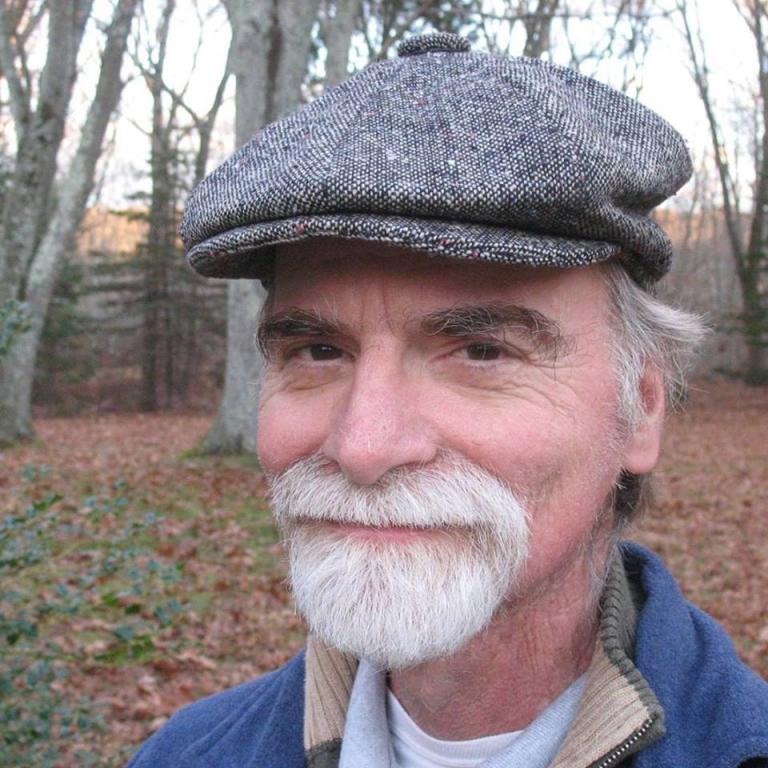
Now? Not so much.
I’ve culled the literature as I’ve pondered those three questions, re-reading Smith and Dayton and familiarizing myself with Mouw, Timothy Keller, Molly Worthen, Roger Olson, the late Stanley Grenz, and others. Especially helpful was Gary Dorrien’s The Remaking of Evangelical Theology, still relevant even though it was published in 1998. Dorrien is a rare find: He’s not an evangelical (he characterized himself as a “dialectical theologian”) but he viewed the tribe with respect, even affection. He read the full breadth of its intellectuals – from Edward J. Carnell to Carl Henry to Bernard Ramm to Donald Bloesch to David Wells to Clark Pinnock to Dayton and Grenz and Olson and beyond. He knows innovative ideas thrive and that the movement pulsates with brain power.
Through Dorrien’s sympathetic eyes, I saw that we evangelicals have nestled into a cozy myth. By “myth,” I don’t mean a “lie” or “false story.” I mean a foundational narrative recited by a group’s members. This particular myth is laced with truth and it’s sincerely told, but it’s been rinsed of awkward particulars. Fact is, today’s turmoil can be traced to the heart of the mid-twentieth century evangelical resurgence, long before the rise of Jerry Falwall, Pat Robertson, and James Dobson. We must face a sober reality when answering the first question (“what went wrong?”). Our well-meaning twentieth-century protagonists, it turns out, were flawed. They weren’t villains and we needn’t spill snark, but we must grasp the full story as we search for a cure.
The story we tell ourselves
The whitewashed narrative goes something like this: An intellectually vibrant and politically neutral evangelicalism resurged in the mid-twentieth century under the leadership of Harold Ockenga (1905-1985), Carl Henry (1913-2003), Billy Graham (1918-2018) and others. Edward J. Carnell (1919-1967) played a role, so did L. Nelson Bell (1894-1973). Oil magnate J. Howard Pew (1882-1971) footed many of the bills. Evangelical Christianity – encompassing a high view of the Bible, a focus on the atoning work of Christ, the need for conversion, and the Gospel’s public demonstration and proclamation – dominated 19th-century American Protestantism but wilted under the assault of theological Liberalism, which – evangelicals claim – yielded far too much to skeptical Modernism. That century’s evangelicalism dissolved into anti-intellectual and separatist fundamentalism in the twentieth century’s early decades. Ockenga and others began calling themselves “neo-evangelicals” and “new evangelicals” in the early 1940’s and led the way out of fundamentalist myopia (the “neo” and “new” were soon dropped). They helped established California’s Fuller Theological Seminary, founded the National Association of Evangelicals – which knit Wesleyans, Dispensationalists, Calvinists, and Pentecostals together in a single alliance – and launched Christianity Today under Henry’s editorship. Alas, politicized right-wing Christianity overtook enlightened evangelicalism and spoiled everything.
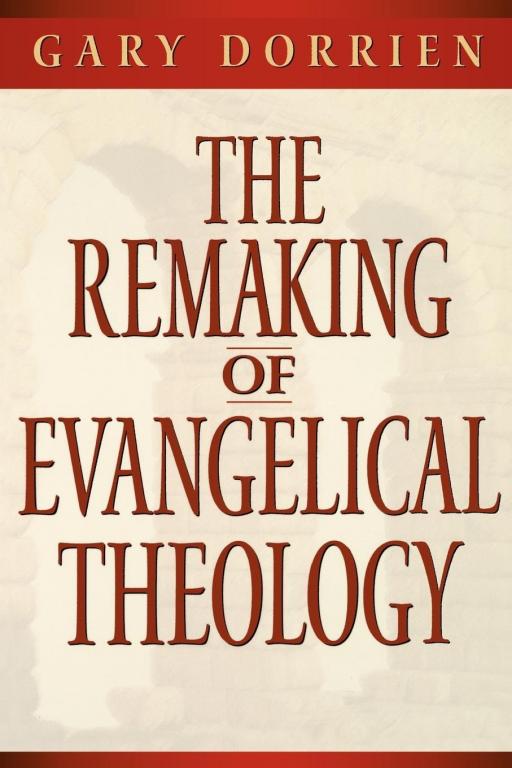 The actuality: That rendering is overly simplistic. The resurgence, a pale flicker of the previous century’s dynamism, limped under the weight of its own theological and cultural insularity. Its leaders, admirable as they were, never fully shed the fundamentalism from which they purportedly emerged. George Marsden captured their ethos in a book title: Reforming Fundamentalism: Fuller Theological Seminary and the New Evangelicalism. The movement’s founders didn’t really establish a distinctive, post-fundamentalist evangelicalism. Carnell, who followed Ockenga as the school’s president, journeyed the furthest in that first generation. Alas, his contribution fell victim to his debilitating clinical depression and early death.
The actuality: That rendering is overly simplistic. The resurgence, a pale flicker of the previous century’s dynamism, limped under the weight of its own theological and cultural insularity. Its leaders, admirable as they were, never fully shed the fundamentalism from which they purportedly emerged. George Marsden captured their ethos in a book title: Reforming Fundamentalism: Fuller Theological Seminary and the New Evangelicalism. The movement’s founders didn’t really establish a distinctive, post-fundamentalist evangelicalism. Carnell, who followed Ockenga as the school’s president, journeyed the furthest in that first generation. Alas, his contribution fell victim to his debilitating clinical depression and early death.
Molly Worthen may have been right when she wrote: “Scratch a neo-evangelical and underneath you would likely find a fundamentalist who still preferred the comforts of purity to the risks of free inquiry and collaboration.”
We see the movement’s theological parochialism in its exaltation of the nineteenth-century Old Princeton theologians (most notably: Archibald Alexander, the gregarious Charles Hodge and the more austere Benjamin Breckinridge Warfield). Their cerebral, categorical brand of Calvinism reigned over Princeton Theological Seminary before the school’s Presbyterian overseers reorganized it in 1929, whereupon some faculty members bolted under the leadership of John Gresham Machen and founded Westminster Theological Seminary near Philadelphia.
It should be said: Charles Hodge and B.B. Warfield, especially, are now favorite targets for supposedly advanced twenty-first-century intellects seeking nineteenth-century whipping boys, which is a pity. We miss their attributes: They sought to be fair to their opponents while exercising scholarly and intellectual rigor. Mark Noll says they fare well when compared to their century’s peers.
Nevertheless, Dorrien was insightful: “The Princeton theology was a form of Reformed orthodoxy that rarely quoted Calvin.” Its adherents eschewed religious experience and lobbed critical shells into the era’s revivals (they didn’t like altar calls or all that messy emotionalism). They followed the Protestant scholasticism of Francis Turretin (1623-1687), who lived a generation after the great Reformer and denounced anything wandering from his version of orthodoxy – as Moses Amyraut (1596-1664) discovered when he tried to fine-tune Calvin’s determinism. Turretin enforced a rigid doctrine of meticulous biblical inerrancy (the entire Bible crumbles upon the discovery of a single discrepancy): God, he claimed, dictated the Scriptures and even inspired the Old Testament’s Hebrew vowel points. Princeton used Turretin’s Institutes as its theological textbook until Hodge’s Systematic Theology replaced it. Warfield, perhaps inerrancy’s most eloquent and sophisticated advocate of the era, pruned the doctrine of the dictation theory and the need for divinely-inspired vowel points, which were actually added centuries after the texts were written. He and A.A. Hodge (the son of the venerable Charles) argued for more nuance in a landmark 1881 essay: Inerrancy applied only to the original autographs; the Bible’s human authors rounded their numbers, employed hyperbole, and wrote in different literary forms. Warfield even allowed that the theory of evolution may be harmonized with the Genesis creation stories. Still, the Princeton theologians were far stricter than either Martin Luther or John Calvin, who invoked inerrancy but didn’t sweat the incongruities inevitable in a book compilation written and collated over a span of centuries.
The resurgence’s leaders argued for Warfield-like inerrancy, which made for awkwardness: Wesleyans either qualified the term or didn’t use it; international evangelicals viewed the doctrine as an American eccentricity. Many agreed with Scottish theologian James Orr (1844-1913), a friend of Warfield’s and contributor to The Fundamentals, a series of booklets foundational to fundamentalism: “It is urged, e.g., that unless we can demonstrate what is called the ‘inerrancy’ of the Biblical record, down even to its minutest details, the whole edifice of belief in revealed religion falls to the ground. This, on the face of it, is a most suicidal position for any defender of revelation to take up.”
Henry and Ockenga, fortunately, plied the term with grace. Both honored non-inerrantist British scholars such as F.F. Bruce and I. Howard Marshal, and Ockenga remained on Fuller’s board after the seminary rewrote its statement of faith and jettisoned the term. So did Billy Graham. Others expanded or qualified inerrancy; still others agreed with Orr and favored infallibility, a broader term allowing space for inconsequential inconsistencies.
But then came Harold Lindsell, who weaponized meticulous inerrancy in 1976 in his incendiary The Battle For The Bible. Lindsell slashed and burned where others deliberated and debated. He even re-enforced fundamentalism’s false dichotomy between care for the poor and evangelism: “As men retreat from inerrancy, they lose any vital interest in evangelism and missions. Their zeal for finishing the job of world evangelization is replaced by socio-political-economic concerns” (19th century evangelists saw no such clash). Inerrancy was now a doctrinal Maginot Line: “I do not for one moment concede … that in a technical sense anyone can claim the evangelical badge once he has abandoned inerrancy.”
Warfield’s nuance evaporated in Lindsell’s hands. The word was now synonymous with scientific precision, forced harmonies and strained explanations (two examples: Lindsell scrambled to explain inexact math in 2 Chronicles 4:2; his harmonization efforts forced him to conclude that the cock crowed six times after Peter denied Christ). Despite bad reviews and criticism from even fellow inerrantists, Lindsell got his wish. Inerrancy evolved into an American evangelical shibboleth, perhaps a password: Whisper it and you’re in the club. Alternative descriptions of the Bible’s veracity – such as arguments for its overall truthfulness, sufficiency, historicity, and authority – were often dismissed as steps toward the slippery slope. Perhaps because of that, subsequent authors strained to maintain the word while expanding its meaning. Indeed, Dan Geoffrey Kent said it eventually sheltered seven definitions, most hinging on authorial intent (if a given author did not intend specificity, then there’s no error). That allows me to sign one of my ordaining denomination’s statement of faith.
Among lay people, however, the word usually conveys scientific precision.
The Straightjacket Tightens
The near-canonization of meticulous inerrancy dovetailed with in-creeping, strict Calvinistic hegemony on all fronts, with an unspoken covenant encircling the movement. Dorrien described it well: “For many years, most of these groups implicitly ceded the right of intellectual leadership to a more cultured and credentialed Reformed establishment. The right to speak for evangelicalism was presumed to belong to Puritan-rooted Baptists such as Henry, Carnell, Billy Graham, and to Calvinists such as (Gordon) Clark, (Cornelius) Van Til, and Berkouer. The existence of other evangelical groups was generally acknowledged, but so was the leadership role of the evangelical establishment.” It’s as if Warfield’s gaze lingers over those bratty Arminians, Pentecostals, and evangelicals rooted in seventeenth-century Pietism, with frowns galore over the followers of Donald Bloesch and Bernard Ramm (they admired Karl Barth) as well as Roger Olson and the late Stanley Grenz. Self-appointed gatekeepers patrol the doctrinal perimeter. The widely-respected Donald A. Carson, for example, has leveled incredible accusations: He questioned Grenz’s evangelical credentials, suspected N.T. Wright of universalism (which Wright fervently denied) and hinted that the Vineyard Christian Fellowship – now a member of the National Association of Evangelicals – may not even be Christian.
The resurgence’s parochialism fanned from its theology into politics. Ockenga sympathized with the libertarianism of his teacher, John Gresham Machen, who saw socialism under every rock. George Marsden says Ockenga and his associates “were Republicans of the sort who supported Robert A. Taft.” True, Billy Graham was a registered Democrat and “a vocal opponent of segregation,” as Eliza Griswold writes. She explained, “Graham fought against cultural strictures and made room for a broad swath of political views. Throughout the nineteen-fifties, he pushed for an agenda that was often as inclusive as that of the political left.” And true, Carl Henry would sign the 1973 Chicago Declaration of Evangelical Social Concern, which summoned the faithful to social justice (although he didn’t exactly ooze enthusiasm; he said he joined the conference because “it seemed better to attend and strive for a balanced position than to simply accommodate a one-sided outcome”). But, at least at the outset, neo-evangelicals were even wary of the moderate-to-liberal Eisenhower Republicans. That doesn’t render them evil, but they unwittingly plowed the soil for the unanticipated Religious Right.
Their insularity grew ominous in their response to one of America’s great moral struggles. Donald Dayton, a Wesleyan scholar, writes that Christianity Today panned the civil rights movement in the 1960’s. Its editors defended “voluntary segregation,” leveled socialism charges against Martin Luther King, Jr.’s call for integration, condemned demonstrations and civil disobedience, and labelled the 1963 March on Washington a “mob spectacle.” They also scorned interracial marriage and hailed Mississippi when the state’s leaders blocked James Meredith from attending its university.
Dayton adds: “The journal, of course, altered its position on most of these issues, but only in response to a reversal of popular consensus or official national policy.”
I hereby squirm. If only the magazine’s writers emulated one of their icons: Warfield called for ending segregation as early as 1887 and condemned racist America as a “wicked caste” society. Instead, they followed Machen, whose bigotry was revealed in a recently-discovered letter to his mother. More information softens the blow even as it breeds confusion. Henry once said this: “Evangelicals stand openly and firmly for racial equality, human freedom, and all forms of social justice throughout the world.” And this: “The gospel resounds with good news for the needy and oppressed. It conveys assurance that injustice, repression, exploitation, discrimination, and poverty are dated and doomed, that no one is forced to accept the crush of evil powers as finally determinative for his or her existence.” He commended Lyndon Johnson in a hand-written note on magazine stationary: The president’s signature on civil rights legislation marked the chief executive’s “finest hour.” And it seems some magazine writers were, indeed, enthusiastic for civil rights: Frank Gaebelein joined the Selma marchers while covering the event, which drew criticism. Henry explained: “Our unwritten code was that reporters of an event should not become public partisans.” Most professional US journalists would agree.
So wherefore the racial insensitivity? Maybe we’re seeing the invisible hand of the magazine’s executive editor, L. Nelson Bell. Bell (1894-1973), Billy Graham’s father-in-law. The kindly physician explained the Gospel to his patients while he was a medical missionary in China from 1916 to 1941. He often prayed for them. He returned to the United States before the Pearl Harbor bombing and, in 1942, founded the Southern Presbyterian Journal, which purportedly defended theological orthodoxy against the modernist tide. Kenneth Taylor describes the Journal’s stance in another arena: “Paternalistic Journalers professed to love African Americans and to want only the best for them. Integration, the writers insisted, was cruel, and segregation was kind. Thus, social separation was consistent with the Golden Rule, ‘to do unto others as you want others to do unto you.’ In 1947 Bell wrote without irony that he was ‘ashamed at the intolerance, the discrimination, and the humiliations which have been heaped on them [blacks] by the white race’ while he defended segregation.”
Henry’s autobiography illuminates Bell’s concealed role at the magazine and in the movement at large. Bell was supposedly Henry’s subordinate, but he secured Pew’s funding, sat on the publication’s board of directors and, it seems, helped usher Henry’s exit. Bell’s job titles downplayed his influence. Sean Michael Lucas inadvertently underscores his stealth in a laudatory article entitled, “Vastly Underrated Leader in 20th-Century Evangelicalism: The Life and Legacy of L. Nelson Bell.” Bell was listed as the Southern Presbyterian Journal’s associate editor, but he was really “the mainspring.” He “wrote more than anyone else, solicited articles, committed financial resources, and guided the policy of the board of directors.”
Lucas pinpointed Bell’s flaw amid the praise: “He represented both the deep longing for revival and the passion for evangelism that has characterized the movement at its best. He also served as an example of the marriage of religious and social conservatism that has sometimes undercut evangelicalism’s gospel mission.”
Perhaps that last sentence describes neo-evangelicalism as a whole. Religious and social conservatism were already betrothed, awaiting the wedding over which Falwell, Dobson, and Robertson presided. Today’s moral, theological, and spiritual calamity shows that the subsequent marriage was abusive: The social conservatism beat back the theological conservatism and now dominates.
A New Movement
So reality, it seems, is more enigmatic than the myth. There were cracks in the foundation. What to do?
Item One on the checklist: Resist snark. The mid-century neo-evangelicals were not villains. They were good men (and “men” they were: this was a white males club, with shirts and ties required). They were pious in the best sense, and they withstood unbridled attacks from the irascible Carl McIntire (1906-2002), head of the fundamentalist American Council of Christian Churches. McIntire’s acrimony embittered Carnell, who blasted fundamentalists in The Case for Orthodox Theology, published in 1959. Fundamentalism, he said, was “orthodoxy gone cultic.” He saw serious flaws in Machen, usually a neo-evangelical protagonist, and peered into the possibility of a distinctive, post-fundamentalist evangelicalism.
Alas, the attacks fed his depression and crippled him.
But most early neo-evangelicals fit Marsden’s characterization. They were “reformed fundamentalists.” Other adjectives help us understand their underlying assumptions and motivations: They were graceful and kind fundamentalists, fundamentalists who longed for their brothers and sisters to emerge from their separatist cocoons, engage the culture, and nurture biblical renewal in mainline denominations. They appreciated those in different evangelical traditions (Wesley’s portrait hung on Ockenga’s wall and he welcomed Pentecostals into the National Association of Evangelicals; Henry, while Reformed, mingled among Wesleyans and spoke at their schools). And, yes, they were flawed fundamentalists. They were lamentably blind to racism, at least at first. I struggle with that and I can’t minimize it. But I also take it as a warning: To which great evil am I blind?
Resisting snark and villainization opens us to Item Two’s opportunities: Recovering a gracious, biblical orthodoxy. I sympathize with Richard Mouw, who cordially argues for the evangelical label’s perpetuation and for the preservation of the wider tradition’s teaching (Mouw anchors himself in a broader, more ecumenical stream of Reformed theology). I’m all for preserving a broader evangelicalism, but it seems best to shelve the label for now. Like it or not, “evangelical” conjures Donald Trump’s image, not our Lord’s. And maybe – while we’re at it – we’ll seize the opportunity: Shifting terms may allow us to take advantage of the shifted terrain. Vatican II narrowed the Protestant-Catholic gap and pathways are opening vis-à-vis Eastern Orthodoxy. Maybe it’s time to try on Thomas C. Oden’s “Classical Christianity,” which preserves the creedal faith while engaging that wider fellowship. The new movement need not be strictly Protestant.
But Item Three ranks as the most vital. I discovered it on July 6, 1973, when I fell in love with Jesus and gave my life to him. I knew nothing about theological tribes or snarling factions. I was just a sloppy Jesus freak, gladly “born again” (the in-vogue term back then). I longed to live in intimacy with Christ and follow him and be like him. That’s why I drank the Scriptures and gobbled Christian literature and attended two Sunday services and a mid-week Bible study and daily prayer meetings. And that’s why I helped establish an inner-city coffee house and led a slew of people to Christ (yeah: I used Bill Bright’s Four Spiritual Laws; so arrest me). I even stopped snapping at my parents.
Perhaps the solution to our present crisis is easier and more profound that we thought. We need to fall in love with Jesus again, which involves less Twitter sniping and more time on our knees. The labels will take care of themselves.








